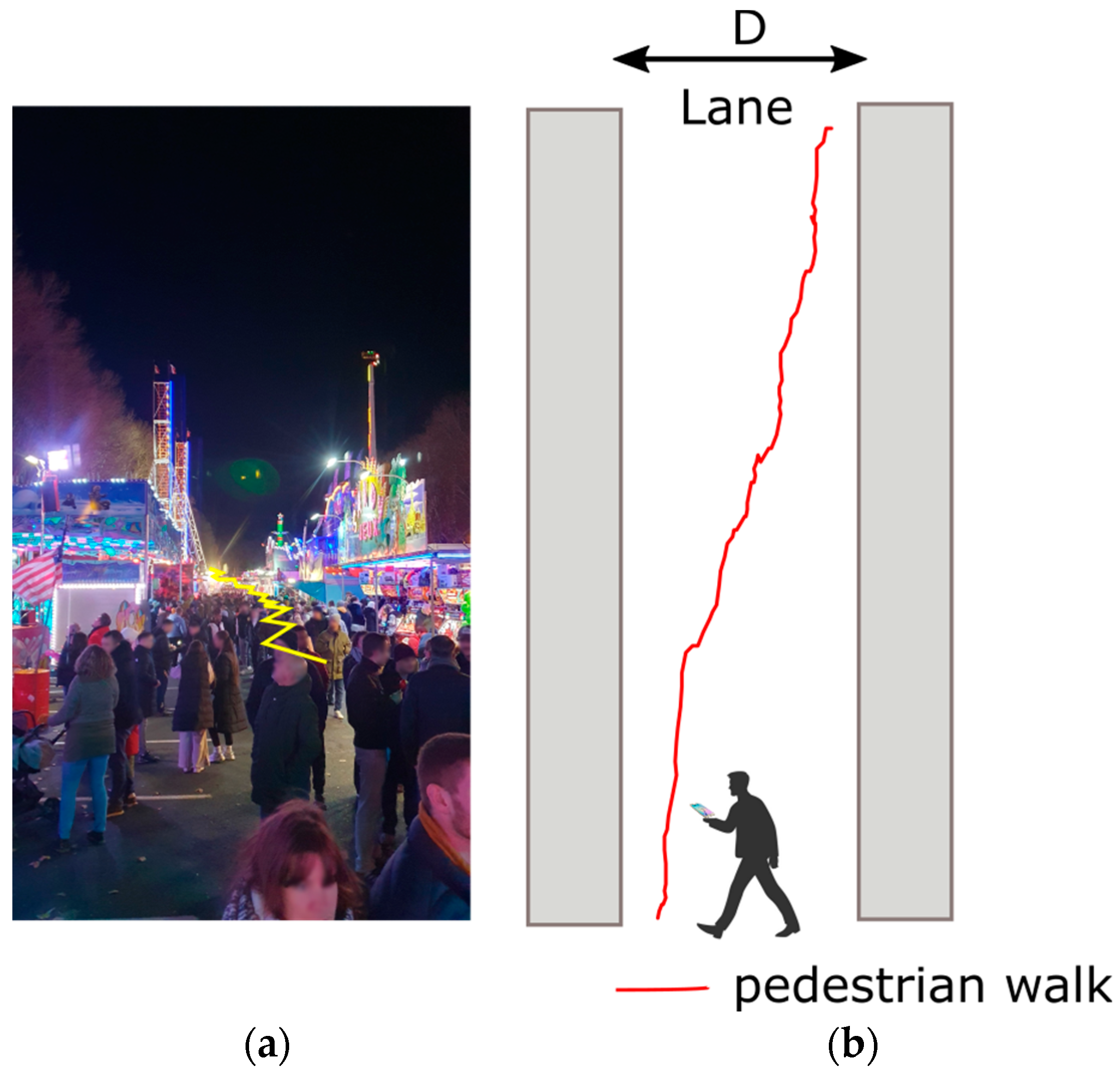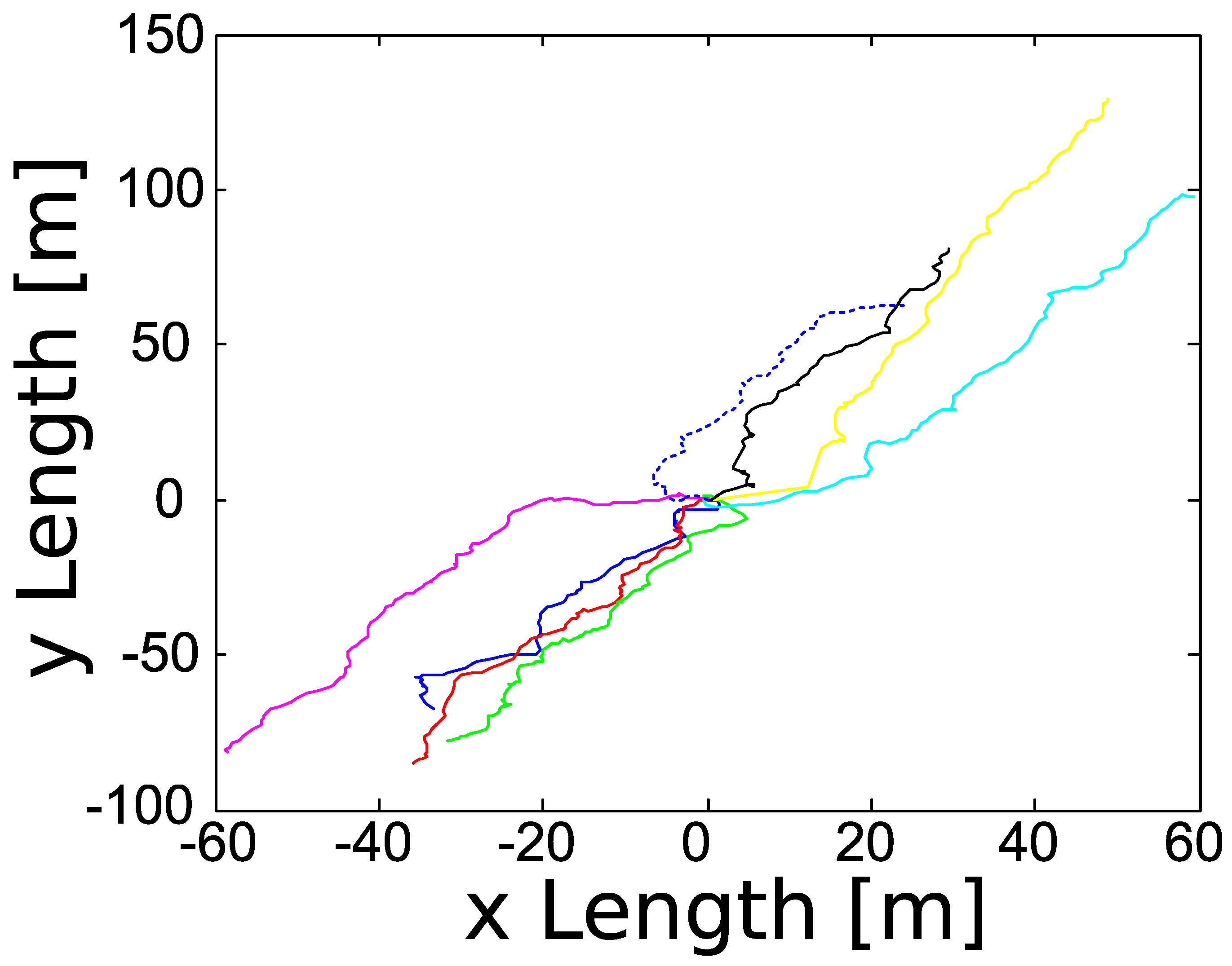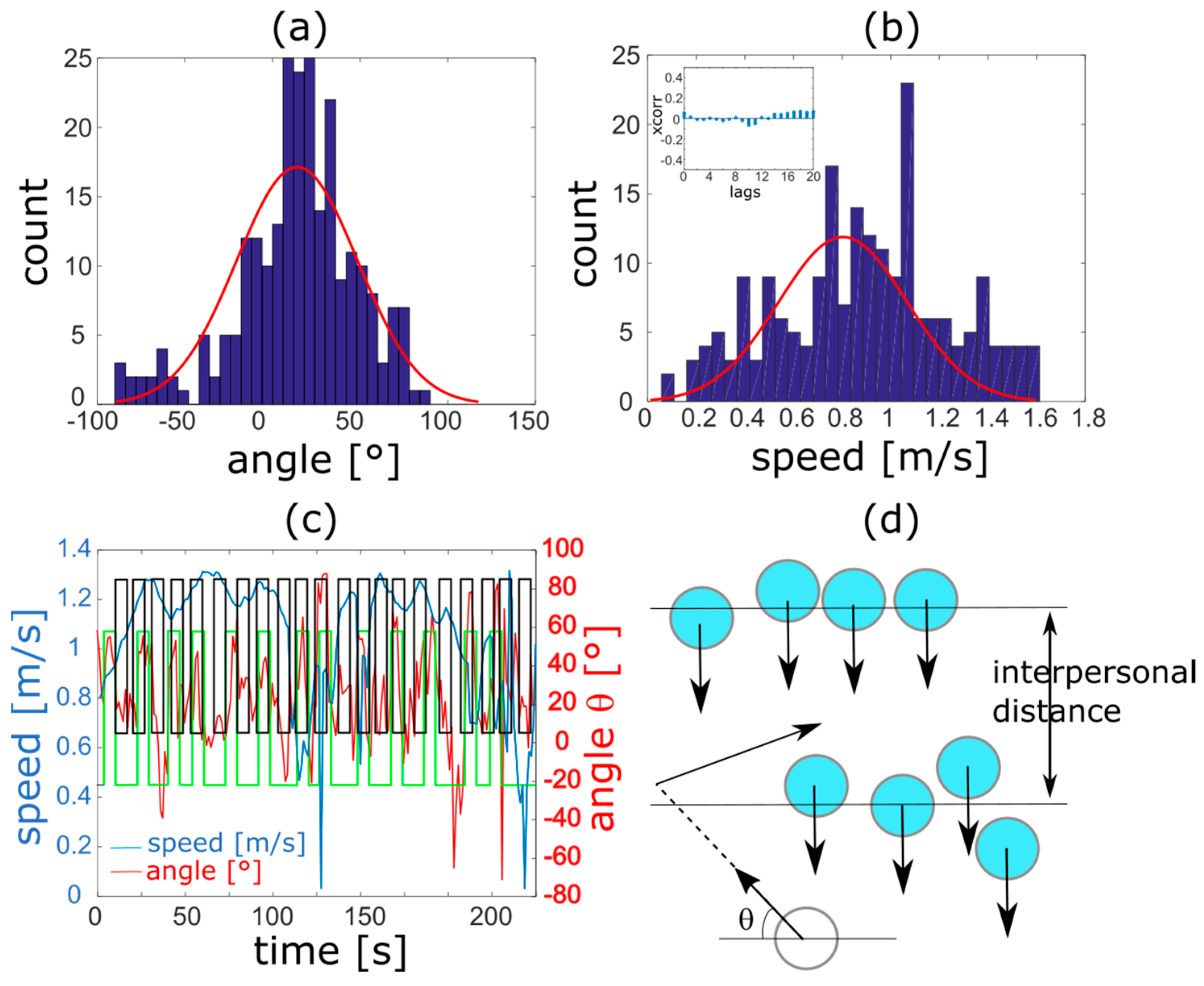Lévy Flight and the Interpersonal Distance of a Pedestrian in a Crowd
Abstract
:1. Introduction
2. Materials and Methods
3. Results and Data Analysis
4. Discussion
5. Conclusions
- (i)
- Mean square displacement (MSD) as a function of time, calculated and plotted on a log-log scale, demonstrates a linear curve that could be fitted with a power law.
- (ii)
- The best-fitted coefficient, greater than 1, indicates that the trajectory is the result of Lévy flight behavior. The MSD histogram is best fitted with a power law featuring an exponential cut-off and another power law.
Funding
Institutional Review Board Statement
Informed Consent Statement
Data Availability Statement
Conflicts of Interest
References
- Brockmann, D.; Hufnagel, L.; Geisel, T. The scaling laws of human travel. Nature 2006, 439, 462–465. [Google Scholar] [CrossRef] [PubMed]
- González, M.C.; Hidalgo, C.A.; Barabási, A.-L. Understanding individual human mobility patterns. Nature 2008, 453, 779–782. [Google Scholar] [CrossRef]
- Corbetta, A.; Bruno, L.; Muntean, A.; Toschi, F. High statistics measurements of pedestrian dynamics. Transp. Res. Proc. 2014, 2, 96–104. [Google Scholar] [CrossRef]
- Bode, N.; Ronchi, E. Statistical model fitting and model selection in pedestrian dynamics research. Collect. Dyn. 2019, 4, 1–32. [Google Scholar] [CrossRef]
- Borgers, A.W.J.; Smeets, I.M.E.; Kemperman, A.D.A.M.; Timmermans, H.J.P. Simulation of Micro Pedestrian Behaviour in Shopping Streets. In Proceedings of the 8th International DDSS Conference, Thessalonike, Greece, 4–7 July 2006. [Google Scholar]
- Kretz, T.; Grünebohm, A.; Kaufman, M.; Mazur, F.; Schreckenberg, M. Experimental study of pedestrian counterflow in a corridor. J. Stat. Mech. Theory Exp. 2006, 2006, P10001. [Google Scholar] [CrossRef]
- Alessandretti, L.; Aslak, U.; Lehmann, S. The scales of human mobility. Nature 2020, 587, 402–407. [Google Scholar] [CrossRef]
- Guo, R.-Y.; Huang, H.-J. Formulation of pedestrian movement in microscopic models with continuous space representation. Transp. Res. Part. C 2012, 24, 50–61. [Google Scholar] [CrossRef]
- Ramos-Fernández, G.; Mateos, J.L.; Miramontes, O.; Cocho, G.; Larralde, H.; Ayala-Orozco, B. Lévy Walk Patterns in the Foraging Movements of Spider Monkeys (Ateles geoffroyi). Behav. Ecol. Sociobiol. 2004, 55, 223–230. [Google Scholar]
- Johansson, A.; Helbing, D.; Shukla, P.K. Specification of a Microscopic Pedestrian Model by Evolutionary Adjustment to Video Tracking Data. Adv. Complex. Syst. 2007, 10, 271–288. [Google Scholar] [CrossRef]
- Goubet, E.; Katz, J.; Porikli, F. Pedestrian Tracking Using Thermal Infrared Imaging. In Proceedings of the SPIE, Defense and Security Symposium, Orlando, FL, USA, 18–20 April 2006. [Google Scholar]
- Seyfried, A.; Boltes, M.; Kahler, J.; Klingsch, W.; Portz, A.; Rupprecht, T.; Schadschneider, A.; Steffen, B.; Winkens, A. Enhanced empirical data for the fundamental diagram and the flow through bottlenecks. In Pedestrian and Evacuation Dynamics 2008; Klingsch, W.W.F., Rogsch, C., Schadschneider, A., Schreckenberg, M., Eds.; Springer: Berlin/Heidelberg, Germany, 2010; pp. 145–156. [Google Scholar]
- Available online: https://geofree.fr/gf/coordinateconv.asp#listSys (accessed on 1 January 2020).
- Pouw, C.A.S.; van der Vleuten, G.G.M.; Corbetta, A.; Toschi, F. Data-driven physics-based modeling of pedestrian dynamics. arXiv 2024, arXiv:2407.20794. [Google Scholar]
- Su, J.; Huang, J.; Qing, L.; He, X.; Chen, H. A new approach for social group detection based on spatio-temporal interpersonal distance measurement. Heliyon 2022, 8, e11038. [Google Scholar] [CrossRef]
- Feng, Y.; Li, D. Improved Social Force Models Considering Heterogenous Characteristics among Social Groups. In Proceedings of the 17th COTA (Conference International Conference of Transportation Professionals), CICTP 2017, Shanghai, China, 7–9 July 2017. [Google Scholar]
- Kohler, L.; Mader, M.; Kern, C.; Wegener, M.; Hunger, D. Tracking Brownian motion in three dimensions and characterization of individual nanoparticles using a fiber-based high-finesse microcavity. Nat. Commun. 2021, 12, 6385. [Google Scholar] [CrossRef]
- Biana, X.; Kimb, C.; Karniadakisa, G.E. 111 years of Brownian motion. Soft Matter 2016, 12, 6331–6346. [Google Scholar] [CrossRef] [PubMed]
- Klafter, J.; Shlesinger, M.F.; Zumofen, G. Beyond Brownian motion. Phys. Today 1996, 2, 33–39. [Google Scholar] [CrossRef]
- Song, C.; Koren, T.; Wang, P.; Barabasi, A.-L. Modelling the scaling properties of human mobility. Nat. Phys. 2010, 6, 818–823. [Google Scholar] [CrossRef]
- Viswanathan, G.M.; Buldyrev, S.V.; Havlin, S.; da Luzk, M.G.E.; Raposok, E.P.; Stanley, H.E. Optimizing the success of random searches. Nature 1999, 401, 911–914. [Google Scholar] [CrossRef]
- Viswanathan, G.M.; Afanasyev, V.; Buldyrev, S.V.; Murphy, E.J.; Prince, P.A.; Stanley, H.E. Levy flights search patterns of wandering albatrosses. Nature 1996, 381, 413–415. [Google Scholar] [CrossRef]
- Benhamou, S. How many animals really do the levy walk. Ecology 2007, 88, 1962–1969. [Google Scholar] [CrossRef]
- Baronchelli, A.; Radicchi, F. Lévy flights in human behavior and cognition. Chaos Solit. Fractals 2013, 56, 101–105. [Google Scholar] [CrossRef]
- Karamouzas, I.; Skinner, B.; Guy, S.J. A universal power law governing pedestrian interactions. Phys. Rev. Lett. 2014, 113, 238701. [Google Scholar] [CrossRef]
- Rhee, I.; Shin, M.; Hong, S.; Lee, K.; Kim, S.J.; Chong, S. On the Levy-Walk Nature of Human Mobility. IEEE/ACM Trans. Netw. 2011, 19, 630–643. [Google Scholar] [CrossRef]
- Feliciani, C.; Nishinari, K. Empirical analysis of the lane formation process in bidirectional pedestrian flow. Phys. Rev. E 2016, 94, 032304. [Google Scholar] [CrossRef]
- Moussaïda, M.; Helbingb, D.; Theraulaz, G. How simple rules determine pedestrian behavior and crowd disasters. Proc. Natl. Acad. Sci. USA 2011, 108, 6884–6888. [Google Scholar] [CrossRef] [PubMed]
- Yan, X.-Y.; Han, X.-P.; Wang, B.-H.; Zhou, T. Diversity of individual mobility patterns and emergence of aggregated scaling laws. Sci. Rep. 2013, 3, 2678. [Google Scholar] [CrossRef]
- Travers, T.; Colin, V.G.; Loumaigne, M.; Barillé, R.; Gindre, D. Single-Particle Tracking with Scanning Non-Linear Microscopy. Nanomaterials 2020, 10, 1519. [Google Scholar] [CrossRef]
- Turchi, P. Quantitative Analysis of Movement; Eds Sunauer Associates: Sunderland, MA, USA, 1998. [Google Scholar]
- Reynolds, A.M.; Ouellette, N.T. Swarm dynamics may give rise to Lévy flights. Sci. Rep. 2016, 6, 30515. [Google Scholar] [CrossRef]
- Edwards, A.M.; Phillips, R.A.; Watkins, N.W.; Freeman, M.P.; Murphy, E.J.; Afanasyev, V.; Buldyrev, S.V.; da Luz, M.G.E.; Raposo, E.P.; Stanley, H.E.; et al. Revisiting Lévy flight search patterns of wandering albatrosses, bumblebees and deer. Nature 2007, 449, 1044–1048. [Google Scholar] [CrossRef] [PubMed]
- Hilborn, R.; Mangel, M. The Ecological Detective Confronting Models with Data; Princeton University Press: Princeton, NJ, USA, 1997; Chapter 7. [Google Scholar]
- White, E.P.; Enquist, B.J.; Green, J.L. On estimating the exponent of power-law frequency distributions. Ecology 2008, 89, 905–912. [Google Scholar] [CrossRef]
- Clauset, A.; Shalizi, C.R.; Newman, M.E.J. Power-Law Distributions in Empirical Data. SIAM Rev. 2009, 51, 4. [Google Scholar] [CrossRef]
- Reynolds, A.; Ceccon, E.; Baldauf, C.; Medeiros, T.K.; Miramontes, O. Lévy foraging patterns of rural humans. PLoS ONE 2018, 13, e0199099. [Google Scholar] [CrossRef]
- Raichlena, D.A.; Woodb, B.M.; Gordonc, A.D.; Mabullad, A.Z.P.; Marlowee, F.W.; Pontzerf, H. Evidence of Lévy walk foraging patterns in human hunter—Gatherers. Proc. Natl. Acad. Sci. USA 2014, 111, 728–733. [Google Scholar] [CrossRef] [PubMed]
- Jin, C.-J.; Jiang, R.; Liu, T.; Li, D.; Wang, H.; Liu, X. Pedestrian dynamics with different corridor widths: Investigation on a series of uni-directional and bi-directional experiments. Phys. A Stat. Mech. Its Appl. 2021, 581, 126229. [Google Scholar] [CrossRef]
- Boltes, M.; Seyfried, A. Collecting pedestrian trajectories. Neurocomputing 2013, 100, 127–133. [Google Scholar] [CrossRef]
- Gorrini, A.; Vizzari, G.; Bandini, S. Age and group driven pedestrian behavior: From observations to simulations. Collect. Dyn. 2016, 1, 1. [Google Scholar]
- Xi, J.-A.; Zou, X.-L.; Chen, Z.; Huang, J.-J. Multi-pattern of complex social pedestrian groups. Transp. Res. Procedia 2014, 2, 60–68. [Google Scholar] [CrossRef]
- Fujita, A.; Feliciani, C.; Yanagisawa, D.; Nishinari, K. Traffic flow in a crowd of pedestrians walking at different speeds. Phys. Rev. E 2019, 99, 062307. [Google Scholar] [CrossRef]
- Chattaraj, U.; Seyfried, A.; Chakroborty, P. Comparison of pedestrian fundamental diagram across cultures. Adv. Complex. Syst. 2009, 12, 393. [Google Scholar] [CrossRef]
- Zhao, Y.; Lu, T.; Su, W.; Wu, P.; Fu, L.; Li, M. Quantitative measurement of social repulsive force in pedestrian movements based on physiological responses. Transp. Res. Part. B 2019, 130, 1–20. [Google Scholar] [CrossRef]
- Huber, M.; Su, Y.-H.; Kruger, M.; Faschian, K.; Glasauer, S.; Hermsdorfer, J. Adjustments of Speed and Path when Avoiding Collisions with Another Pedestrian. PLoS ONE 2014, 9, e89589. [Google Scholar] [CrossRef]
- Murakami, H.; Feliciani, C.; Nishinari, K. Lévy walk process in self-organization of pedestrian crowds. J. R. Soc. Interface 2019, 16, 20180939. [Google Scholar] [CrossRef] [PubMed]
- Mann, R.P.; Garnett, R. The entropic basis of collective behavior. J. R. Soc. Interface 2015, 12, 20150037. [Google Scholar] [CrossRef] [PubMed]
- Cordes, J.; Schadschneider, A.; Nicolas, A. Dimensionless numbers reveal distinct regimes in the structure and dynamics of pedestrian crowds. PNAS Nexus 2024, 3, 120. [Google Scholar] [CrossRef] [PubMed]
- Liu, J.; Jia, Y.; Mao, T.; Wang, Z. Modeling and simulation analysis of crowd evacuation behavior under terrorist attack. Phys. A Stat. Mech. Its Appl. 2022, 604, 127891. [Google Scholar] [CrossRef]
- Katada, Y.; Hasegawa, S.; Yamashita, K.; Okazaki, N.; Ohkura, K. Swarm Crawler Robots Using Lévy Flight for Targets Exploration in Large Environments. Robotics 2022, 11, 76. [Google Scholar] [CrossRef]





Disclaimer/Publisher’s Note: The statements, opinions and data contained in all publications are solely those of the individual author(s) and contributor(s) and not of MDPI and/or the editor(s). MDPI and/or the editor(s) disclaim responsibility for any injury to people or property resulting from any ideas, methods, instructions or products referred to in the content. |
© 2024 by the author. Licensee MDPI, Basel, Switzerland. This article is an open access article distributed under the terms and conditions of the Creative Commons Attribution (CC BY) license (https://creativecommons.org/licenses/by/4.0/).
Share and Cite
Barillé, R. Lévy Flight and the Interpersonal Distance of a Pedestrian in a Crowd. Appl. Sci. 2024, 14, 7585. https://doi.org/10.3390/app14177585
Barillé R. Lévy Flight and the Interpersonal Distance of a Pedestrian in a Crowd. Applied Sciences. 2024; 14(17):7585. https://doi.org/10.3390/app14177585
Chicago/Turabian StyleBarillé, Régis. 2024. "Lévy Flight and the Interpersonal Distance of a Pedestrian in a Crowd" Applied Sciences 14, no. 17: 7585. https://doi.org/10.3390/app14177585




